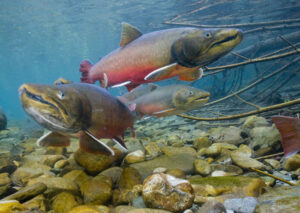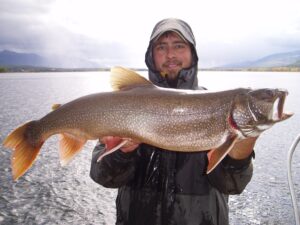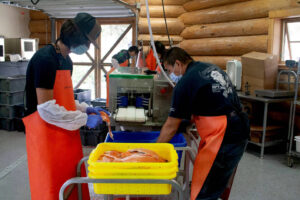The Beginning
In 1492, European settlers stumbled upon the Americas in search of land, wealth, and territories to colonize.
However, the land they “discovered” was already occupied by millions of indigenous people and thousands of unique tribes with beautiful, distinct languages and cultures.
And with the arrival of these European colonists came non-native diseases, including smallpox, which, being previously non-existent in the Americas, resulted in multiple waves of epidemics across indigenous populations.
This invisible enemy decimated tribes, resulting in a much quicker conquest of the Americas for Europeans.
It Continues
What is often overlooked in this narrative of invasion are the other three categories of invasives brought by European colonists—plants, insects and animals—that have caused sustained distress in disproportionate amounts to indigenous peoples.
One of these—the invasive lake trout—provides a powerful example of how modern policy continues to leave native populations out of conservation management conversations, to their continued detriment.
Bull trout, Lake Trout, and the Confederated Salish and Kootenai Tribes
The Flathead Reservation in Montana is home to the Confederated Salish and Kootenai Tribes (CSKT).

The CSKT and Montana Fish, Wildlife and Parks co-manage Flathead Lake, a 197 square mile body of water that is home to a variety of fish species.
Bull trout are a culturally significant native species to Flathead Lake. They have been a staple of the CSKT diet for countless generations and are particularly valued for their flavor.
In 1999, however, bull trout were listed as a threatened species under the Endangered Species Act. At the time, it was estimated that there were under 1,000 bull trout remaining in the world.
You may ask yourself, “What caused the sudden depletion of a native trout that used to number in the millions?”
The answer is an intentionally introduced invasive species—in this case, the lake trout.
A First Invasive Species
Historically, lake trout are native to upper North America, specifically, the glacial lakes. To survive, lake trout need deep, cool waters, typically over 100ft in depth.
Lake trout were introduced to Flathead lake in 1905 by Montana state officials with the intent of adding variety to the fishing scene.
The species was selected because of its ability to grow very large, very fast, two traits that are appealing to anglers.
However, there were unforeseen consequences that came with introducing an invasive species.
In particular, officials underestimated the species’ resiliency, which enabled it to begin crowding out native species, like the bull trout.
A Second (and Third) Invasive Species

Lake Trout numbers were relatively low until the 1980s, however, when something changed. Lake trout numbers went from several thousand to several hundred thousand
This was because another invasive was introduced.
This time, it was mysis, a small shrimp that thrives in cool water. These shrimp were introduced in an attempt to provide more food for Kokanee salmon (the third invasive species).
Fortunately, the Kokanee salmon did not experience the population boom that the mysis were brought in to provide; instead the lake trout found themselves with a near unlimited supply of shrimp.
A trophic cascade ensued, and the lake trout population increased to the point where mysis became scarce, resulting in lake trout eating the fry of other native fish species, as well as their own young. Bull trout were unable to compete, and their numbers dwindled.
An Opportunity to Restore Balance

Although the state of Montana caused this problem by introducing an invasive species to benefit westerners, it neglected to attempt to fix it when lake trout started to take over. So, in the early 2000s, the Confederated Salish and Kootenai Tribes generated an adaption strategy to try and save their bull trout.
The CSKT began to harvest lake trout by the thousands (60,000 annually), laying hundreds of feet of dragnet on the lake’s floor. They worked in tandem with a program, Native Fish Keepers, Inc., that helped sell the harvested lake trout and reinvested their proceeds back into the program.
As opposed to eradicating lake trout, the CSKT approached the issue as an economic opportunity, and they have seen their bull trout numbers steadily improve as a result.
Continuing the Conversation

Historically, indigenous people in the Americas haven’t been given a seat at the table to discuss wildlife management strategies. Inclusive land management techniques are often overlooked. They have been described as complex, costly and difficult to understand. America’s white colonist lens has prevented us from acknowledging indigenous knowledge and prioritizing it above western knowledge.
The success of the Confederated Salish and Kootenai Tribes in managing the lake and bull trout populations in Flathead Lake, however, points the way forward.
Recently, too, the Tribal Wildlife and Grants Program has allocated some funding for a select number of tribes. Additionally, America’s Wildlife Act, which is currently before the Senate, would allocate nearly one billion dollars to restoring native species in America, including collaboration with indigenous tribes.
Get Involved Today!
If you participate in recreational fishing, make sure that you familiarize yourself with the history of the waters you’re fishing. Aside from acknowledging the original stewards of waterways, you can check here to see if the species you’re targeting is invasive.
This educational indigenous waterways research report also can help you educate yourself about indigenous waterways conservation techniques.
Traditional knowledge and land management techniques are equally, if not more, critical than western practices. If you’re non-Native American and you’re reading this, we need to stop the invasion and prioritize the original stewards of this land.


That animal species not only humans but all animals species have the capacity to populate new territories especially if they are more successful than the native species. Native Americans immigrated from Asia, Asians immigrated from Africa, so on and so forth. This battle about saving native species is almost redundant when the introduce species is biologically more successful. If you really wanted to save the bull trout all you have to do is create a stocking program. Lake trout mostly inhabit lakes so their expansion capacity is very limited limited, where as bull trout can inhabit lakes but prefer Rivers. By the way in case you didn’t know lake trout are native to North America and to Canada and often co-inhabit with bull trout in the majority of Canada. So where do you guys get this idea that Lake tread are invasive foreigners thet somehow cannot share the same environment with bull trout when it naturally occurs throughout their native range? Humans are funnier than trout.